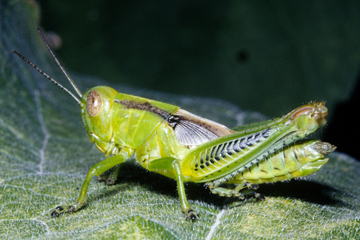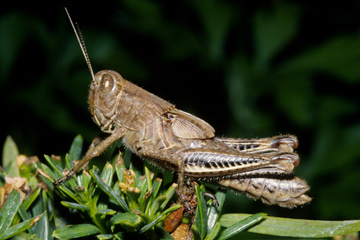G1633
A Guide to Grasshopper Control in Yards and Gardens
This NebGuide discusses grasshopper damage to yards and gardens, strategies to reduce the problem, and methods to achieve control.
Gary L. Hein, Extension Entomologist
John B. Campbell, Extension Entomologist
Ron C. Seymour, Extension Educator
 |
Twostriped nymph |
 |
Differential nymph |
Grasshopper populations fluctuate in cycles. High or very high populations may be present for two to four years followed by low to moderate populations for several years. Even when overall populations are relatively low, grasshoppers in and around the garden can be a nuisance. In outbreak years, however, grasshoppers can destroy unprotected gardens and threaten small trees and shrubs.
Grasshopper damage occurs most frequently in areas with less than 25 inches annual rainfall. In most years, the western half of Nebraska falls into this high risk category; however, grasshoppers can be a problem throughout the state.
Damage
Over 100 grasshopper species occur in Nebraska; however, only four grasshopper species — the migratory, differential, twostriped, and redlegged — cause most damage in yards and gardens. The potential for grasshopper damage increases as summer progresses. Adults will be more likely to move into yards and gardens in July and August. Severe problems may arise when adjacent agricultural crops or grasslands mature or are harvested and grasshoppers move to find new food sources. Defoliation is the primary injury to plants, but fruit and ripening kernels of grain also will serve as food sources.
Grasshoppers show a preference for flowers and some garden vegetables (e.g. lettuce, beans, sweet corn), but when populations are high they will feed on nearly all garden vegetables, as well as trees and shrubs. Defoliation of larger trees will have limited impact unless this defoliation continues for more than one year. Small trees and shrubs will be the most seriously affected.
Grasshoppers will feed on just about anything as long as they do not detect a feeding deterrent. Reports are common of grasshoppers eating paper, paint, window screen, window caulking, fenceposts, hoe handles, etc. during grasshopper outbreak periods. These feeding habits need to be considered. Aluminum window screen is tough enough to resist grasshopper damage but other fabric screen is not.
Life Cycle
There are three stages in the grasshopper life cycle — the egg, nymph, and adult. The female lays the eggs in the soil and surrounds the eggs with a frothy liquid that hardens to form a protective structure or “pod”. The number of egg pods deposited by a single female may range from 7 to 30, and the number of eggs per pod may vary from 8 to 30, depending on the species. Typically, a female grasshopper will lay about 100 eggs during the summer and fall. Outbreaks are favored when females produce more eggs as a result of better food quality and/or an extended period in the fall to lay eggs. Egg pods are deposited in the upper few inches of soil in non-tilled areas, such as grasslands, pastures, ditches, etc. Some grasshoppers prefer to lay eggs in soil surrounded by roots of grasses while other species select open areas with only surface debris.
Grasshopper Management Strategies Grasshopper management can be effective and practical if the area to be protected is relatively small and isolated; however, protecting a garden from grasshoppers moving out of a large area of adjacent grassland or cropland may be impossible. Several strategies can be employed to help manage grasshopper problems:
|
Eggs are well protected by the insulation of the pods and can survive extremely cold temperatures. A few grasshopper species spend the winter as nymphs. Most of these species are “bandwings,” large grasshoppers that make a crackling noise when in flight. These are seen early in the spring and usually are not numerous enough to cause serious injury.
Hatching time is influenced by temperature, with earlier hatching occurring after a warm spring. The egg hatch for a single species may extend over a month or more. The earliest hatching grasshopper of concern in gardens is the twostriped grasshopper. It begins to hatch about mid May or earlier if the spring is unusually warm. Eggs of the migratory grasshopper will begin to hatch about a week after those of the twostriped grasshopper, and redlegged and differential grasshoppers will begin to hatch about three weeks after the twostriped grasshopper.
Nymphs must start feeding within one day after egg hatch and usually feed on the same plants as the adult. Because of limited fat reserves, young nymphs are vulnerable to adverse weather just after hatching. Extended cool temperatures (less than 65°F) and rainy weather during this early hatching period can result in starvation of the young nymphs. Grasshopper nymphs go through five instars, or stages of development. After each instar, they shed their cuticle (skin) and grow larger. Grasshopper nymphs normally reach the adult stage in five to six weeks.
Adult grasshoppers, the only stage to have wings, readily move out of hatching areas and begin egg laying one to two weeks after becoming adults. Adults live two to three months, depending on the weather. All developmental stages are influenced by temperature, and grasshopper growth can be advanced or retarded by favorable or unfavorable temperatures.
Natural Control
There are several natural enemies of grasshoppers, and while some of these become more numerous when outbreak populations occur, they are not likely to prevent populations from moving into yard and garden areas. Natural enemies work in concert and their overall effect will significantly impact seasonal populations.
A few of the most common and effective predators of grasshoppers include robber flies, spiders, and blister beetle larvae (on egg pods). Perhaps the most effective and practical natural enemy for use in yards and gardens is poultry, especially guinea hens and turkeys. However, some poultry may cause substantial injury to the garden. Even these predators may be overwhelmed during outbreak years.
A common parasite of grasshoppers and crickets is the horse-hair or gordian worm. These nematodes, up to 4 inches in length, become more numerous in outbreak years, but their life cycle requires water, limiting their effectiveness in dry areas. Another predator is a small red parasitic mite that can lodge itself under the grasshopper wings. These mites may stress the grasshoppers, resulting in fewer eggs or a shorter lifespan, but they are not likely to dramatically affect current populations.
Several diseases can impact grasshopper populations. A fungal disease caused by Entomophthora grylii may be the most noticeable. It causes infected, dying grasshoppers to crawl to the tops of grasses where they wrap their legs around the grass stem and die. Impacts from this disease are often not seen until late in the season.
Spores of the protozoan Nosema locustae are commercially available as a formulation on bran bait (called Semaspore, Nolo-Bait). The spores must be applied against small grasshoppers (3rd to 4th instar) in and near the hatching areas to be effective. This disease will act slowly and may take an entire season to reduce populations. It will have minimal impact on later instars or adult grasshoppers that move into yards or gardens.
Chemical Control
Chemical control is often the best alternative for eliminating heavy infestations of grasshoppers. Adult grasshoppers are difficult to control with insecticides due to their size and decreased susceptibility to the insecticides. The best time to control grasshoppers is during the 3rd and 4th instars when they are 1/2 to 3/4 inch long. These stages will occur in mid to late June. At this time most eggs will have hatched and the young hoppers will be more susceptible to insecticides. Also, they will still be concentrated in their hatching areas, and they can be controlled more effectively than when dispersed later in the summer.
|
Table I lists insecticide options available for yard and garden use. Read and follow all directions and precautions on the insecticide label. Most products are formulated in a liquid or mixable dry formulation, and will be registered for use on certain vegetables, turf, ornamentals, or non-crop use. The same active ingredient may be found in numerous different brand name products.
Carbaryl is the only product that is formulated as a bait for grasshopper control. The insecticide is impregnated onto wheat bran flakes or into small pellets. This dry formulation can be useful in and around the garden, especially if there are no recurring infestations from surrounding areas. The bait is easy to apply by hand and can be spread without directly contacting the plants, avoiding residues. Bait blowers can be used to treat larger areas. Bait should be applied to the soil surface or areas of minimal surface residue or canopy so the grasshoppers can easily find it. It needs to be re-applied after rain or heavy dew as it will not persist under these conditions.
The sources of grasshopper infestations (i.e. surrounding grasslands, ditches and other untilled areas) should be treated before the larger adult hoppers move out. Often homeowners do not own the adjacent areas, and treatment may not be possible. In this case, the only option is to use protective sprays to protect as much of the yard and garden as possible. These insecticides will only have a few days of residual activity and repeated applications will be necessary. If most grasshoppers are adults, the best control will be obtained by using the maximum labeled insecticide rates for these products.
| To simplify technical terminology, trade names sometimes may be used. No endorsement of products is intended nor criticism implied of products not mentioned. |
Visit the University of Nebraska–Lincoln Extension Publications Web site for more publications.
Index: Insects and Pests
Other Pests
Issued July 2006